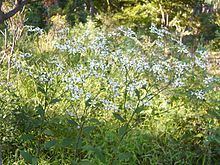Rank Species | ||
 | ||
Similar Kalimeris, Aster ovatus var microcephalus, Aster ageratoides, Doellingeria, Synurus | ||
Doellingeria scabra is a perennial herb of the Compositae family from Eurasia. It is frequently found in wild mountain regions of Korea, eastern Russia, China and Japan.
Contents
Doellingeria scabra thrives in the dry mountain ranges of Korea. It is known for its distinctive fragrance and taste, and is frequently used in Korean cuisine. Known among locals for its medicinal use, studies show it contains many beneficial compounds. It's Korean name is chamchwi(참취, "true chwi"), and it is often simply referred to as chwinamul(취나물, "chwi namul") by the Korean locals.
Distribution
Doellingeria scabra is native to Eurasia, which includes eastern Russia, China, Japan, and Korea. It is actively cultivated in temperate regions of Korea for varying uses.
Habitat and Ecology
Doellingeria scabra is found in woods and thickets. Low hills and mountains frequently harbor its growth. Forest clearings and warm temperate areas suit it well. Moist soil and full sun conditions are ideal for A. scaber Thunb. It can be cultivated in lightly sandy, loamy, or clay soils. Adequately drained soil is needed. It cannot grow in the shade.
Description
Doellingeria scabra grows up to 1.2 meters (4 ft). Its stems stand tall. Its hermaphrodite flowers bloom between August to October. Its seeds ripen between September to November. Insect pollinators such as bees and flies aid pollen exchange. It is capable of self-fertilization. The palmate venation leaves are green and Cordate-shaped. Its edges are serrated; jagged and resemble saw blades. Trichome can be found all over its surface.
Korea
In Korean cuisine, chamchwi along with other chwinamul varieties are often used as the main ingredient of herbal side dishes called namul. It is also one of the ingredients that frequently feature in bibimbap recipes. It can be used as a herb in kimchi, rice, and even Korean-style Italian pasta dishes. It is also used as a ssam vegetable.
Dishes
Medicinal
Traditional Eastern medicine used Doellingeria scabra for its various medicinal effects. Ground D. scabra can be used to treat external wounds and snakebites by applying directly to the skin. Studies have shown that D. scabra aqueous extract can be used to improve immune response via increased macrophage activation in mice over the course of 4 weeks. D. scabra most notably upped pro-inflammatory cytokines, nitric oxide, and expression of iNOS and COX-2. It displays anti-carcinogenic, anti-oxidant, and anti-inflammatory activities. When treated with reactive oxygen species, its protective effect can be maximized by blanching with hypochlorite ion. Preparation time directly affects its anti-oxidant ability. Caffeoyl quinic acid from its extract has shown to display inhibitory activity against HIV-1 integrase.
